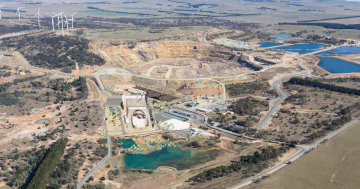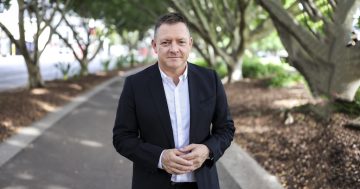
Amendments will be made to plans for the Advanced Energy Recovery Centre near Tarago. Photo: Veolia ANZ.
Issues around Veolia ANZ’s waste incinerator or Advanced Energy Recovery Centre (ARC) facility (however you classify it) continue to drag on, with the plan now needing amendments – 18 months after the original went on public exhibition.
In a statement, the business explained the amendment to the Woodlawn Eco-Precinct in Tarago centred on air pollution control residue (APCr) and making it “better align” the project with the long-term water management plan for the area.
“The amendment involves implementing a more comprehensive method of stabilisation and treatment of air pollution control residues (APCr) from the ARC facility, which enables the reclassification of the stabilised APCr as general solid waste that is safe for disposal in the Woodlawn Bioreactor landfill,” it stated.
“The flue gas treatment and filtration is exactly the same. The stabilisation process is very similar, but rather than using portland cement as a stabiliser, other fillers and binders would be used.
“Veolia is still investigating the preferred options.”
(APRc is a by-product from energy recovery facilities captured by air pollution control systems. It’s also known as ‘fly ash’ and typically includes a mixture of ash, carbon and lime).
The amendment would also see the removal of the previously proposed encapsulation cell from the project, and also relocate the APRc stabilisation area to be adjacent to the main energy-from-waste building.
A contingency plan will be included to allow stabilised APRc to be transported off-site for disposal, should it not meet the standards needed for disposal at the Woodlawn Bioreactor landfill site.
The project has attracted community backlash for years, with the Goulburn Mulwaree Regional Council previously lodging “total opposition” to the facility.
The Yass Valley and Queanbeyan-Palerang regional councils have also voiced their concerns and pleas have also been made for the ACT community to oppose the NSW project.
Communities Against the Tarago Incinerator (CATTI) said the NSW Government’s “alarm bells should be ringing” over Veolia’s need to amend their plans yet again.
“Veolia states it is an expert in incineration, but what they have demonstrated to the community is a lack of proper planning, an EIS so full of holes it’s taken Veolia more than a year and a half to respond to community submissions, and a hazardous waste ‘mismanagement’ plan that now proposes dumping hazardous material into an ordinary landfill,” the group said in a statement.
“If there’s ever a company that has fully demonstrated unsuitability to manage an incinerator and its toxic by-products, Veolia is it.”
CATTI pointed to previous EPA breaches by the company and voiced concerns about allowing it to transport waste through towns and alongside farming land.
“There is no safe way to manage and monitor these toxins in the landfill, and particularly not when this landfill sits within the Sydney Water Catchment and onsite leachate has already seeped into local groundwater,” they said.
“Veolia’s proposal to also truck this same contaminated waste through our towns and along local roads to Sydney is terrifying.”
The Veolia ANZ statement outlined the need for amendments was identified towards the end of 2023, following the public exhibition period of the project’s environmental impact statement (EIS) from October to December of 2022.
“As part of the amendment process, Veolia will undertake an additional range of stakeholder engagement opportunities, which will provide the community with an understanding of the proposed amendment, its implications, and provide the potential for feedback,” a statement read.
The Department of Planning, Housing and Infrastructure (DPHI) will ultimately decide whether the changes need to go on public exhibition, which is expected.
It’s hoped the amendment report will be shared around November.
This will change the project’s approval timeline, given more submissions would be accepted from the public and then Veolia would be able to respond.
Finally, the DPHI would prepare an assessment report for the Independent Planning Commission to make a final decision on its development application.
Veolia has previously outlined the project’s expected to generate up to 30 megawatts of electrical energy (enough to power 40,000 homes) from about 380,000 tonnes of residual waste each year.









